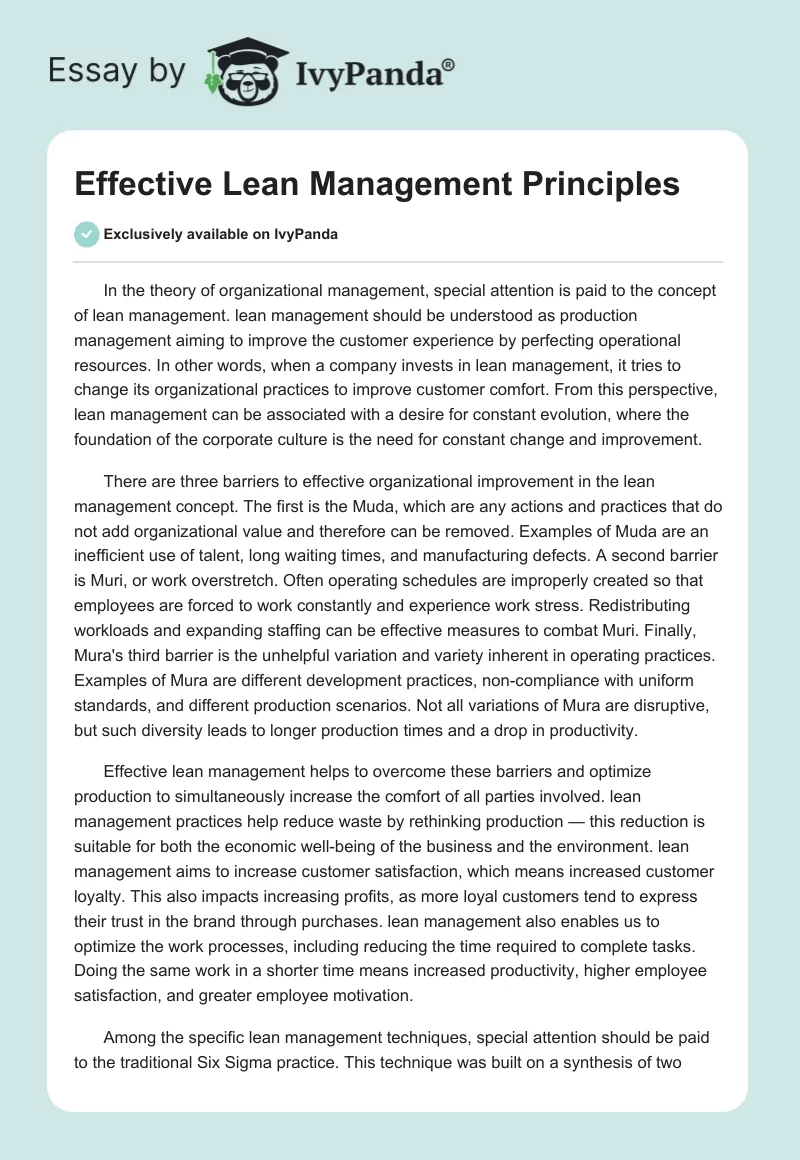In the theory of organizational management, special attention is paid to the concept of lean management. lean management should be understood as production management aiming to improve the customer experience by perfecting operational resources. In other words, when a company invests in lean management, it tries to change its organizational practices to improve customer comfort. From this perspective, lean management can be associated with a desire for constant evolution, where the foundation of the corporate culture is the need for constant change and improvement.
There are three barriers to effective organizational improvement in the lean management concept. The first is the Muda, which are any actions and practices that do not add organizational value and therefore can be removed. Examples of Muda are an inefficient use of talent, long waiting times, and manufacturing defects. A second barrier is Muri, or work overstretch. Often operating schedules are improperly created so that employees are forced to work constantly and experience work stress. Redistributing workloads and expanding staffing can be effective measures to combat Muri. Finally, Mura’s third barrier is the unhelpful variation and variety inherent in operating practices. Examples of Mura are different development practices, non-compliance with uniform standards, and different production scenarios. Not all variations of Mura are disruptive, but such diversity leads to longer production times and a drop in productivity.
Effective lean management helps to overcome these barriers and optimize production to simultaneously increase the comfort of all parties involved. lean management practices help reduce waste by rethinking production — this reduction is suitable for both the economic well-being of the business and the environment. lean management aims to increase customer satisfaction, which means increased customer loyalty. This also impacts increasing profits, as more loyal customers tend to express their trust in the brand through purchases. lean management also enables us to optimize the work processes, including reducing the time required to complete tasks. Doing the same work in a shorter time means increased productivity, higher employee satisfaction, and greater employee motivation.
Among the specific lean management techniques, special attention should be paid to the traditional Six Sigma practice. This technique was built on a synthesis of two paradigms, Six Sigma, and lean management, but over time has come to be seen as a single and valuable practice. Lean Six Sigma is an operational analysis system based on fragmenting a company into parts to optimize production; this includes the need to reduce defects.
Lean Six Sigma practice highlights the use of five-step techniques, DMAIC and DMADV, which help explore different facets of the business consistently. The use of these models helps plan production optimization from problem definition to consolidation of results and reflection. However, there are several differences between the approaches. DMAIC, unlike DMADV, focuses on the current process rather than the product being developed. The nature of the approaches also differs: DMAIC is reactive in that it eliminates defects as soon as they are detected, while DMADV, by contrast, is proactive in that it is responsible for minimizing defects during new product development.
In lean management, it is an inherent practice to use the concept of seven wastes. These wastes include transportation, inventory, waiting and traffic, overprocessing and overproduction, and defects. Each of these wastes is a useless activity and adds no value to the customer. However, it affects the product’s final value and can backfire when the customer is forced to pay for a useless activity.
This concept is based on five principles in terms of the lean management foundation. These include defining value and mapping the value stream. These maps put the customer at the center of attention and identify all activities that lead to improved customer interactions. It also includes flow after waste disposal, limiting stock levels, and the constant pursuit of excellence.
The instrumental approach to lean management includes many tools, but the classic ones are five. These are value stream mapping, takt time, cause-and-effect chart (or Ishikawa), load balancing (or Heijunka), and mistake-proofing (or Poka-yoke). Using these tools helps to systematize improvements and discover the greatest number of weaknesses needed for change.


